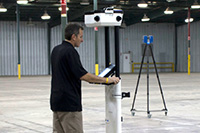Planning, budgeting, construction management – engineers today are tasked with a lot more than just design and implementation – they are tasked with ensuring success.
Particularly in renovation projects, thorough due diligence and evaluating the existing facility is critical to identify its strengths, weaknesses, and potential risks. In many cases, this too falls to the engineer. That said, there is a case that as-built surveys/laser scanning and documenting the facility in CAD or Revit are ideal tasks for a trusted AEC service professional. After all, do your clients come to you because you’re great at data collection or because you’re great at design?



